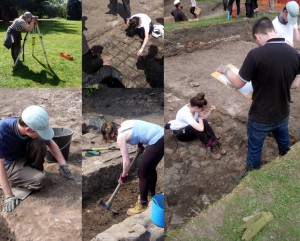Archaeologists from Cheshire West and Chester Council will be returning to Grosvenor Park, Chester to run their annual training dig for second-year archaeology students from the University of Chester.
Why are they digging in the park? 
Grosvenor Park sits next to two important historical monuments, the Roman amphitheatre and the medieval church of St John the Baptist. Both of these have had an influence on the development of the park and, more importantly, on what lies beneath. For example, written records tell us that Cholmondeley’s Mansion and buildings belonging to St John’s Church were located in the park but how much remains and what did these buildings look like? Chester’s Roman fortress, which lay to the west, would have been surrounded by a civil settlement. Does any of that survive?
So far the students have uncovered a Roman road, a large building destroyed during the Civil War and a wide ditch running north-south across the park. The building appears to have been related to St John’s Church, probably part of the medieval hospital and chapel of St Anne, which was acquired by Sir Hugh Cholmondeley in the late 16th century and developed as part of his mansion. This season they hope to discover more about the layout of the medieval building and its post-medieval successor and to find further evidence for the civil settlement outside the Roman fortress.
Lisa Harris, Director of Place Strategy, Cheshire West and Chester Council, said: “Our previous digs have always attracted a lot of attention. These digs not only provide essential practical experience for students working alongside our archaeologists but have been a talking point for the many visitors to the park. There is always an opportunity to watch the activities and get an update on what’s been discovered. This is part of our commitment to invest in inclusive leisure and culture making west Cheshire a great place to live and visit. Please follow the blog, watch the ongoing dig and make a date in your diary for the open day.”
The training dig is a partnership project between archaeologists from Cheshire West and Chester Council’s Cultural Service (Grosvenor Museum) and the University of Chester and is an essential part of the students’ archaeology degree course. Dr Caroline Pudney, lecturer in archaeology at the University of Chester (who recently appeared in the Channel 4 programme, Britain’s Most Historic Towns, praising the Roman history of Chester), said: “We are so lucky to have such a major archaeological site on our doorstep, and for our students to have the opportunity to contribute to our knowledge of the city’s past. Chester’s Roman history has had its public profile raised recently, as it was the focal point of the Channel 4 programme, presented by Professor Alice Roberts. She was so impressed by our amphitheatre that she referred to it as her favourite site . Additionally, the varied nature of Chester’s post-Roman past provides a wide range of historic remains and therefore a unique environment for discovery that helps to inspire our students to further their archaeological experience.”
The training dig will be open for viewing by the public from May 3rd to May 30th, 9.30am to 4.30pm Monday to Friday (except between 12.30pm – 1.30pm daily and all day on Bank Holiday Mondays). An Open Day will be taking place on the afternoon of May 29th (1.30 – 4.30pm), giving members of the public the chance to see first-hand what the students have uncovered and learn more about the history of this corner of Chester. Further information and updates will be available on the students’ Dig Blog during the excavation.
